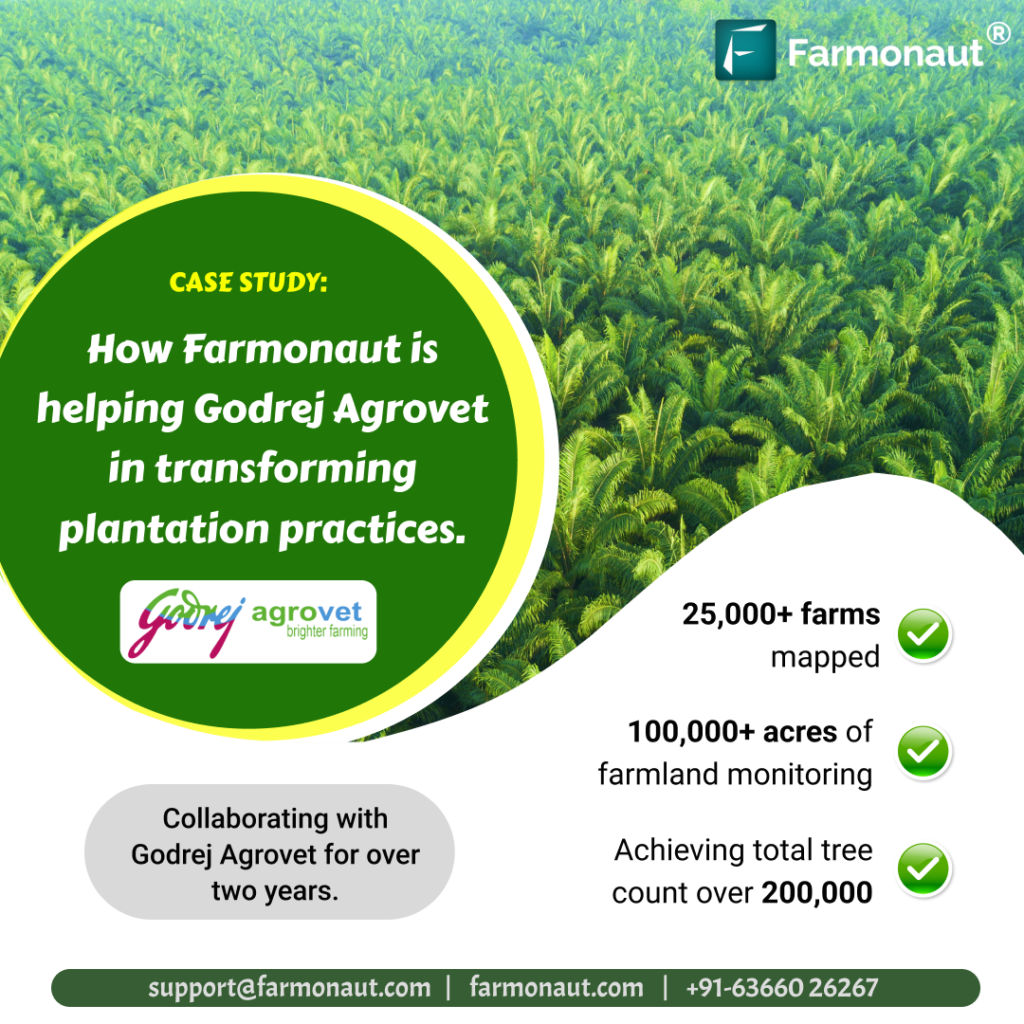Black Aphids: 7 Powerful Ways to Control Damage in Crops
Summary: Black Aphids Identification, Impact, and Management
Black aphids are small, sap-sucking insects that present significant threats to crops and trees, both in agriculture and forestry. Their damaging feeding habits, ability to cause distorted plant growth, and transmission of various plant diseases make them a critical pest. Effective black aphid control methods require an integrated combination of cultural, biological, and chemical approaches, as well as advanced monitoring solutions like those provided by Farmonaut. By deeply understanding the biology of black aphids, their impact, and the available management strategies, we can ensure the health and productivity of our agricultural systems and forests.
Introduction: Understanding Black Aphids
Within modern agriculture and forestry, black aphids are a persistent challenge. Their capacity to damage various crops and trees has significant impacts on both small-scale and large-scale farming operations worldwide. As a group of small insects with rapid reproduction and complex lifecycle habits, they can quickly establish extensive and damaging infestations.
Our efforts to control these pests are critical not only for immediate yield protection but also for long-term sustainability and the reduction of resource wastage. In this comprehensive guide, we will explore the science, symptoms, and practical solutions for identifying, managing, and ultimately mitigating the threats posed by black aphids.
The Biology and Identification of Black Aphids
A critical first step in aphid infestation management is accurate identification. Black aphids are not a single species but rather a group of insects within the aphid family characterized by their distinctive dark coloration. Understanding the various species, their physical traits, and biology, helps us recognize and respond to infestations effectively.
What are Black Aphids?
- Size: Typically 1/16 to 1/8 inch (1.5 to 3 mm) in length.
- Coloration: Shades of deep black to dark brown.
- Body Structure: Soft-bodied, oval-shaped with long antennae and two short tubes (cornicles) at the rear.
Some common species include:
- Black bean aphid (Aphis fabae): A significant threat to beans, beet, and spinach.
- Black cherry aphid (Myzus cerasi): Targets cherry trees, causing leaf distortion.
- Cowpea aphid (Aphis craccivora): Damages legumes, peanuts, and other agricultural crops.
Where are Black Aphids Found?
- Primarily on the undersides of leaves, tender shoots, and flower buds.
- Thriving in moderate, humid climates—common in agricultural fields and forest edges.
Their preferred habitats facilitate undetected feeding, allowing populations to grow rapidly.
Impact and Signs of Aphid Damage in Plants
Black aphid feeding and the resulting damage is multifaceted, leading to both direct and indirect impacts. Recognizing the signs of aphid damage in plants early is essential for timely and effective interventions.
Direct Damage: The Cost of Aphid Feeding
- Sap Extraction: Aphids pierce plant tissues with their specialized mouthparts, extracting vital sap.
- Growth Reduction: Continuous sap loss results in reduced plant vigor, stunted growth, and can even lead to plant death in severe cases.
- Leaf Curling and Distorted Foliage: Common symptoms include curling, yellowing, and distorted leaves or shoots, harming both appearance and productivity.
- Flower and Fruit Deformation: Feeding on developing buds and fruits causes malformations and reduced yields.
Indirect Damage: Sooty Mold and Disease Transmission
- Honeydew Production: Black aphids excrete a sticky substance (honeydew) that accumulates on leaves and stems.
- Sooty Mold Caused by Aphids: This sugary honeydew promotes the growth of black sooty mold fungi, which covers plant surfaces and reduces photosynthesis, leading to premature leaf drop and weakened plants.
- Disease Transmission: Aphids are vectors for numerous plant viruses (e.g. cucumber mosaic, melon mosaic, potato leaf roll, lettuce mosaic), spreading infection when moving between infected and healthy plants.
The combined effect of growth loss, virus transmission, and secondary mold infections can cause significant economic damage across agricultural systems and forest plantations.
Recognizing Signs of Aphid Damage in Plants
- Noticeable leaf curling, yellowing, or stunting
- Presence of shiny, sticky honeydew on leaves and stems
- Black or brown sooty mold growth on plant surfaces
- Clusters of small black insects on the undersides of leaves and new shoots
- Abnormal fruit and flower development
Early identification enhances the success of aphid infestation management and helps us maintain plant health.
Life Cycle and Ecology of Black Aphids
Understanding the biology of black aphids is central to designing integrated pest management for aphids. Their life cycle is highly adaptable, supporting rapid population buildup under favorable conditions.
Key Stages of Aphid Development
- Egg Stage: In colder climates, aphids lay eggs on woody hosts to overwinter.
- Nymphal Stages: Eggs hatch in spring, releasing nymphs that mature in several molts, often bypassing sexual reproduction through parthenogenesis (females producing live young).
- Adult Stage: Adults may be wingless or winged, enabling them to move and colonize new plants as populations grow or resources dwindle.
Environmental Factors Contributing to Black Aphid Outbreaks
- Mild temperatures (15–25°C) and moderate humidity accelerate aphid population growth.
- Dense planting arrangements and excessive nitrogen fertilization (making plants more succulent) significantly increase risk and severity of infestations.
- Weed presence nearby provides alternative hosts, fueling the spread.
By closely monitoring environmental conditions and using digital farm management tools like those from Farmonaut, we can anticipate potential aphid outbreaks and respond proactively.
7 Powerful Aphid Control Methods in Agriculture & Forestry
Combating black aphids in crops and trees requires a holistic approach—integrated pest management for aphids—that strategically combines cultural, biological, and chemical control methods. Below, we present the 7 most effective strategies for sustainable aphid control and reduced crop damage.
1. Crop Rotation
- Rotating crops disrupts the life cycle of aphids, reducing population buildup year-over-year.
- Growing non-host crops discourages black aphid establishment in the same soil.
- A vital cultural control tactic for healthy agricultural systems.
- Tip: Integrate satellite guidance from large-scale farm management platforms to plan rotational patterns for maximum benefit.
2. Pruning and Physical Removal
- Regularly remove heavily infested plant parts to limit aphid populations and break the cycle of disease transmission.
- Use clean tools to avoid spreading aphids or viruses between plants.
- Disposal of residues off-site helps ensure infestations do not return.
3. Weed Management and Sanitation
- Weeds often act as alternative hosts, allowing black aphids and related plant viruses to overwinter and persist between production seasons.
- Keeping field edges clean reduces threats in both agriculture and forestry.
- Schedule regular sanitation rounds, especially at critical plant growth stages.
4. Proper Irrigation and Plant Nutrition Management
- Healthy plants are far more resilient; they can withstand or recover from minor damage caused by sap-sucking insects.
- Avoid excessive nitrogen fertilization; it produces soft, lush plant tissue that is highly attractive to aphids.
- Use satellite-based monitoring or carbon footprinting tools from Farmonaut to optimize water and resource use efficiently across your farm or forest plots.
5. Biological Control: Encouraging Natural Predators of Aphids
- Cultivate an environment that attracts beneficial insects such as:
- Lady beetles (ladybugs)
- Lacewing larvae
- Syrphid (hover fly) larvae
- These natural predators of aphids are highly effective in reducing black aphid populations without harming non-target species or chemical residues.
- Tip: Flowering strips or companion planting boosts beneficial insect populations.
For rapid results during heavy infestations, consider purchasing and releasing commercially reared beneficial predators, which is especially valuable in greenhouses or secluded forest nurseries.
6. Biological Control: Harnessing Entomopathogenic Fungi
- Fungal biopesticides such as Beauveria bassiana and Verticillium lecanii infect and kill aphids naturally, reducing populations with minimal impact on the farm ecosystem.
- Best applied in moist environments or in the evening.
- An eco-friendly option within the broader integrated pest management for aphids toolkit.
7. Chemical Control for Aphids: Targeted, Responsible Use
- Insecticidal Soaps & Oils: Biodegradable, contact-based formulas disrupt aphid cell membranes and are notably effective while preserving most beneficial predators.
- Systemic Insecticides: These chemicals are absorbed by the plant, delivering targeted control as aphids feed on sap. CAUTION: Always follow label instructions to minimize environmental impact.
- Contact Insecticides: Rapidly kill exposed aphids on application but often require multiple treatments and careful rotation to avoid resistance development.
- For any chemical option, coordinate interventions with regular monitoring, and deploy selectively—only when thresholds are exceeded.
For real-time crop health tracking and optimal application timing, leverage Farmonaut’s satellite-driven crop health and pest advisory tools via the web, Android, or iOS app.
Comparative Effectiveness Table: Black Aphid Control Methods
| Control Method | Estimated Effectiveness (%) | Application Frequency | Suitable Crop Types | Environmental Impact | Estimated Cost |
|---|---|---|---|---|---|
| Cultural Control (Crop Rotation, Pruning, Sanitation) | 60-75 | Seasonal/As needed | All field & horticultural crops, forestry | Low | Low |
| Weed & Alternate Host Management | 50-65 | Bi-weekly–Monthly | All crops, including forestry | Low | Low |
| Proper Irrigation & Nutrient Management | 40-50 | Ongoing | All crops, orchards, forestry | Low | Low |
| Encouraging Natural Predators | 65-90 | Seasonal / With severe infestation | Vegetables, orchards, field crops, forestry seedlings | Very Low | Medium |
| Biological Fungi (Entomopathogenic) | 60-85 | 2-3 times per season | Vegetables, horticultural crops, forest nurseries | Very Low | Medium |
| Insecticidal Soap & Horticultural Oils | 60-75 | After rain/Every 7-14 days | Vegetables, field crops, fruit trees, ornamentals | Low | Low |
| Systemic & Contact Insecticides | 85-98 | 1-3 times per outbreak | All crops (use as last resort) | Medium–High | Medium–High |
Integrated Pest Management for Aphids: The Ultimate Approach
The evolving challenge of black aphid infestations calls for an integrated pest management for aphids (IPM) model—one that prioritizes sustainability, effectiveness, and environmental responsibility. This approach combines multiple control methods, minimizing reliance on any single tactic and avoiding the pitfalls of resistance or unnecessary crop damage.
Why Choose an IPM Approach?
- Reduces chemical dependence, promoting biodiversity and ecological health.
- Slows or prevents resistance development among black aphid populations.
- Adapts flexibly to changing pest pressure and new scientific developments.
- Optimizes input use, reducing costs and safeguarding long-term soil and crop health.
Key Steps in Aphid IPM
-
Monitor Regularly: Inspect fields, orchards, and forest plantings weekly.
Tip: Automate monitoring with Farmonaut’s satellite-based crop health tracking, identifying likely aphid hotspots before symptoms are obvious. - Set Action Thresholds: Only initiate chemical interventions when aphid populations reach levels that threaten economic or ecological goals.
- Rotate Control Methods: Cycle between cultural, biological, and chemical approaches to reduce the likelihood of resistance and maximize effect.
- Encourage Ecosystem Resilience: Increase biodiversity—through companion planting, field margins, or leaving beneficial refuge zones—so natural enemies flourish and contribute to sustainable pest control.
- Evaluate & Adapt: Review results seasonally to tweak strategies for improved upcoming cycles.
How to Get Rid of Black Aphids: Combining Methods for Lasting Success
- Begin with prevention (cultural practices), monitor closely, and escalate only as needed.
- Focus on healthy plant maintenance: Proper irrigation, soil health, and resource-use insights keep plants resilient and lower the risk of severe infestations.
- Preserve populations of natural predators of aphids—avoid broad-spectrum insecticides if possible.
- Engage professional guidance as needed, or use AI-powered apps like Farmonaut for advisory support tailored to your crop and location.
Farmonaut & Precision Monitoring: Smarter Pest Management
The future of aphid infestation management lies in combining integrated pest management for aphids with advanced digital tools. Farmonaut delivers a new standard for large-scale pest and disease surveillance, making us more proactive and accurate in our management decisions.
Farmonaut’s Satellite-Based Crop Health Monitoring
- Real-time, multispectral satellite images track vegetation health, stress, moisture, and potential pest outbreaks across vast acreage.
- AI-driven advisory (Jeevn AI system): Analyzes current and historical data to recommend targeted interventions, optimizing pest management and minimizing chemical inputs.
- Accessible Apps & API: Seamless integration across Android, iOS, browser, and API (API access | Developer Docs) to empower everyone from small farmers to large enterprises and government bodies.
Holistic Farm Management Solutions
- Resource & Fleet Management: Optimize logistics across farms and plantations—see how Farmonaut’s fleet tools cut costs and boost sustainability.
- Blockchain Traceability: Enhance supply chain transparency and consumer trust using Farmonaut’s traceability platform.
- Carbon Footprinting: Measure and minimize environmental impact with Farmonaut’s carbon tracking—perfect for eco-conscious farmers.
- Crop Loan & Insurance Verification: Use satellite-based proof to access crop insurance and loans with increased reliability and speed.
All these features make Farmonaut an essential co-pilot in the fight against black aphids and other yield-limiting threats, democratizing access to precision agriculture worldwide.
FAQ: Black Aphid Control & Plant Health
What are black aphids and why are they a threat?
Black aphids are sap-sucking insects from several species (like Aphis fabae, Myzus cerasi, and Aphis craccivora) found on a wide range of crops and trees. Their feeding reduces plant vigor, causes distorted growth, transmits diseases, and can result in major yield losses in agriculture and forestry.
How can I identify a black aphid infestation early?
Look for clusters of small, black insects on the undersides of leaves, new shoots, and flower buds, as well as sticky honeydew deposits, sooty black mold, and distorted or curled leaves.
What are the main natural predators of aphids?
Key natural aphid predators include lady beetles, lacewing larvae, syrphid fly larvae, and some parasitic wasps. Attracting or releasing these can keep aphid numbers naturally in check.
How do I choose between biological and chemical control for aphids?
Adopt biological controls (beneficial insects, fungi) as your first line for mild to moderate infestations or in sensitive crops. Reserve chemical control for aphids for severe or rapidly escalating outbreaks, and always apply it judiciously to avoid harming non-target organisms and strengthening resistance.
How can Farmonaut technology help in aphid control?
Farmonaut offers satellite-based crop health monitoring, AI-driven advisory systems, and digital resource management tools. These technologies improve monitoring, optimize interventions, and help farmers use their resources more effectively—leading to better pest management and healthier crops. Download via web, Android, or iOS apps to get started.
How can I prevent sooty mold caused by aphids?
Sooty mold caused by aphids is best prevented by controlling aphid populations early, removing honeydew-coated leaves, and ensuring good field hygiene (weed and residue management). Timely interventions—especially with biological and cultural techniques—reduce honeydew buildup and keep plant photosynthesis levels high.
Can I use Farmonaut for forestry pest management?
Absolutely. Farmonaut’s crop plantation & forest advisory tools (learn more here) use satellite-based insights to support proactive pest, disease, and resource management across forestry operations and plantations as well as agricultural land.
Conclusion: Maintaining Healthy, Productive Crops & Trees
Black aphids continue to pose a significant threat to agriculture and forestry worldwide. Their rapid reproduction, ability to cause both direct and indirect damage, and their role as vectors for devastating plant diseases mean growers must remain vigilant. By integrating a multifaceted pest management strategy—grounded in cultural, biological, and responsible chemical controls—and leveraging digital tools like Farmonaut’s crop monitoring and advisory, we can effectively reduce aphid populations, protect yields, and foster more resilient agricultural systems.
Remember, the key to lasting success is proactive monitoring, supporting natural predator populations, maintaining plant health, and only escalating responses as necessary. New technologies—including real-time satellite imagery, AI-based guidance, and traceability solutions—empower us to move beyond reactive spraying to truly integrated pest management for aphids in the digital age.
Ready to take your pest management to the next level?
Explore Farmonaut’s affordable, advanced monitoring and advisory options—start protecting your crops and forests with powerful, science-based solutions today!
















